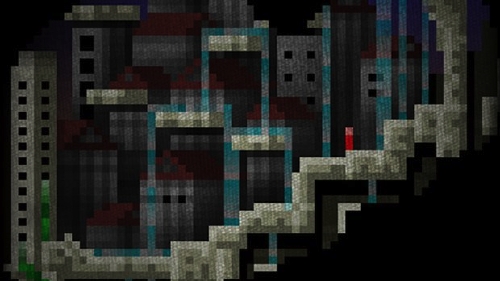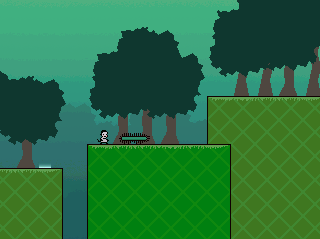Recently, I've been trying to think about the aesthetic and emotional balance of transmedia works. Many have written before that transmedia flourishes when each individual part of a transmedia experience utilizes the strengths of its respective medium. For example, if a movie is paired with a video game, is it beneficial to incorporate cinematic aesthetics into the video game, or should the producers focus on the interactivity that video games afford (and most films do not)? There are certainly arguments for both sides. Whatever the final decisions of the production team, the individual parts of the transmedia experience will affect and impact the transmedia narrative's audience in specific ways.
Henry has written before that "the core aesthetic impulses behind good transmedia works are world building and seriality" (The Aesthetic of Transmedia [Part 2]). Although Henry states that he wishes to see transmedia narratives flourish in genres beyond "fantasy and science fiction franchises", he concedes, "[T]he transmedia approach enhances certain kinds of works that have been udged [sic?] harshly by traditional aesthetic criteria because they are less concentrated on plot or even character than more classically constructed narratives."
While this article will avoid issues of transmedia, I want to explore more the idea of world building (Henry's first core aesthetic of transmedia works) as possessing successful emotional potential for an audience.
In the same article, Henry writes, "It's long been a charge directed against science fiction works that they are more interested in mapping complex environments than in telling compelling stories," but I would argue that complex environments can give rise to a well of emotional response that in turn create the foundations for compelling stories.
After the jump, I'll be exploring three video games that utilize world building and exploratory participation to craft complex stories out of very simple aesthetics.
I had the pleasure this past weekend of playing a handful of single-player video games, namely:
1) Small Worlds, a simple Flash game.
2) Knytt, a 2D side-scroller for the PC.
and 3) Flower, available on the Playstation 3.
The theme that binds these three games together is exploration: each games thrives in its own right because it pushes the player to explore as much of the world as possible. In fact, exploration is inherent to each game, and by exploring, the player essentially builds the world. Of course, each world is prefabricated, but the act of exploring each uncharted land creates a wonderful feeling of mystery combined with victory as the world unfolds in front of the player.

Small Worlds is a wonderful introduction to exploratory gaming, particularly because you can play it for free online. It's also very short, only taking about fifteen (15) minutes to beat all the way through.
The game opens with one line, "There is too much noise," and transitions into a world of large pixels. You are a "man" in "red clothes": in other words, one pink pixel over two vertical red pixels. And you appear in what seems to be a dome, amidst ambient background music.
Again, the objective is very simple: move around with arrow keys, jump occasionally, and explore. Immediately, you realize that you can't go outside the dome, so you must explore below ground. But as you move, the world zooms out, opening up a dozen paths to travel down. Eventually the world expands, becoming infinitely larger. You encounter a flickering light, a glowing red alarm, and many more structures.
What they all mean is hidden, until you keep exploring. And it is through exploration that the world is built and the "story" unfolds. Well, if there is even a story to be told. Any narrative seems to be up to the player to create out of all the landmasses and buildings encountered. All you come to realize is that the world is much bigger than you ever imagined.
Like an RPG without any dialogue or non-playable characters, Small Worlds exists to explore, well, small worlds (which, I suppose, are actually Big Worlds). The game reminds me, perhaps due to the music and coloration, of Square's Chrono Trigger for the Super Nintendo. Aesthetically, these two games are not comparable -- clearly, Chrono Trigger possesses more advanced graphics, music, etc. But emotionally, the act of exploring both these worlds produces the same sense of awe, surprise, and intrigue.

Knytt is similar to Small Worlds in that its aesthetics are very toned down. In fact, it's style could very well fit that of the Nintendo or Gameboy Advance families, and if you've played a number of these games in the past, you'll notice that Knytt oddly resembles the EarthBound series (also known as Mother in Japan).
The premise of Knytt is that your playable character is abducted by an alien, who then crashlands on an unknown planet. To reach the skies again, you must explore this new world to retrieve pieces of the space ship for its repair. Like Small Worlds, you can explore with arrow buttons and jump around, but also climb up walls and buildings. Additionally, you're equipped with a light beam of some sort, which you'll just have to figure out how to use by yourself!
Knytt's world is expansive like a traditional side-scroller: the screen moves directionally in frames (unlike Small Worlds, where it zooms out to display the rest of the world). And to retrieve all the parts of the ship, the player must explore as much of the world as possible. Knytt relies, again, on exploration, but also thrives in storytelling because there is no story. Along the way, different beings and buildings are discovered, but it seems that ultimately no interaction is possible, which allows for Knytt to ask an infinite number of unanswerable questions, further duplicating a burdening sense of intrigue.
Because the mode of exploration is transitory (as in, you cannot see the world as a whole; versus Small Worlds, which is permanent once you explore each region), Knytt begs the question: what exactly is this world? Therefore, it allows for re-exploration, continually returning to questions from the past. Obviously once the game is complete, such actions are impossible, but I wonder if this introduces another question: Is it possible for a transmedia experience to succeed past its initiative? Does an extensive narrative have potential for people to revisit it beyond the initial target experience timeline?
These questions might be unanswerable until we see actual case studies, but Knytt succeeds in those areas where it does not have to do much work: the questions that create a sense of mystery. And perhaps the target of the game -- rebuilding the space ship -- is ultimately less important than the action of attempting to understand what the world of Knytt is all about.
Knytt is available for free download, but you can only play it on a Windows operating system.

Like Knytt and Small Worlds, Flower is an ordinary game of exploration that opens up worlds of beauty (just watch the gameplay trailer above to see how beautiful this short game really is). Flower was produced by thatgamecompany, an independent American video game developer, also known for its developers' work on a game with similar foundations, flOw.
The premise of Flower is -- as strange as it sounds -- that a flower in a dull city dreams of life in a vibrant field. The player takes control of a petal and guides it through vast levels, awakening other flowers and bits of nature in a wonderful crescendo of color. If this does sound weird, Jenova Chen (designer) stated during production, "When we started, we didn't know what we were making. We just had this concept that every PlayStation is like a portal in your living room, it leads you to somewhere else. I thought, 'Wouldn't it be nice if it was a portal that would allow you to be embraced by nature.'"
Going along with the theme, the player in Flower is allowed to explore the world, controlling the city's evolution into a wild garden. Flower perhaps more applicable to my initial thoughts on transmedia, however, because it's a recent game that takes advantage of modern aesthetics preferred by contemporary audiences, and perhaps special effects along the lines of what we would see from a recent transmedia narrative. The novel element of Flower, though, is that it evades any sort of fantasy of science fiction theme. Actually, I'm not sure if it fits into any stereotypical themes at all -- which is perhaps why it was received so well.
Flower is also similar to the other two games in that it strongly utilizes ambient music to move its narrative. However, maybe it's the act of exploration that moves this game rather than its story, since it seems to avoid possessing a story altogether (unlike the former games, which at least hint at one).
While the game only costs $10 for a download, Flower might be out of range for most folks (upwards of $200 to buy the Playstation 3, without even purchasing a nice television on which to use the system).
So, in the end... What can we learn about transmedia, aesthetics, and world building from these (not-transmedia) video games?
First, world building takes on roles two-fold. Obviously, a world must be crafted by the producers of the transmedia experience for it to be, well, experienced. However, when put into the hands of an audience (the participatory half), the world further evolves as fans explore the franchise to its depths. Companies have already started to expand the experience of films, for example, by implementing social media strategies to extend the characters' interaction with audiences. But the question remains: Does the success of transmedia lie in the ability for the franchise to extend beyond the primary medium (eg., when the audience interacts with a film through Flickr or Twitter), or does it rely on the exploration of the franchise through its primary mediums (should the experience in a film and video game be interactive to a wild extent that audiences will remain intrigued beyond the initial viewing/playing)? Also, though there are not many test cases, we have yet to see a transmedia franchise utilize the maximum potential of world building by fans through the development of a story beyond that created by the industry. In the future, how exactly will the relationship between industry and audiences play out in the grand scheme of building a transmedia world or universe?
Second, world building can comprise the experience, but only to the extent that audiences retain interest. Perhaps the interactive nature of video games espouses exploration and therefore can kindly draw from world building as a primary source of attention. Given the Star Wars films, for example, it can be argued that most of the exploration resides in the engrossing Star Wars Encyclopedias. World building, instead of actual construction, might better be understood as the completion of a block or field of knowledge in each audience member's mind. Hence, different world will be built as audiences experience transmedia in different ways. Is it therefore possible for a viewer to "complete" a transmedia experience, if the world is in fact so vast? And how to we avoid conflating different "audiences" if only some have completed partial narratives (eg., those that never played Enter the Matrix, but watched the complete Matrix film trilogy)?
There are many possible questions over which to ponder, since transmedia is still in early stages of development and discourse. If you too have thoughts, please comment below!





One aspect of the evolving transmedia experience that isn't receiving quite as much exposure as I believe it deserves is the development of a transparent relationship between content creators and audience.
http://zenfilms.typepad.com/zen_films/
The metamorphic interface between migratory audiences and independent filmmakers who are exploring extended storyworlds is particularly fascinating, and the collaborative possibilities potentiated are every bit as magnetic as the prospect of immersive storyworlds that exceed the traditional limitations of discretely segmented media.